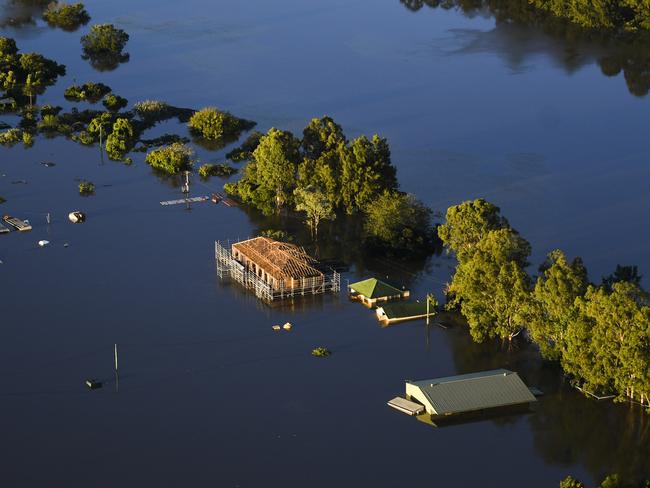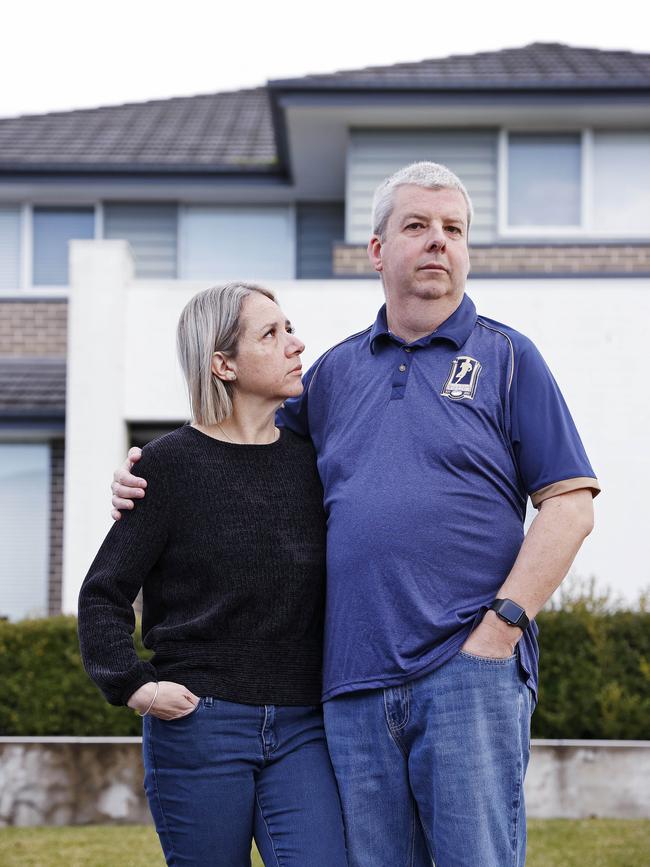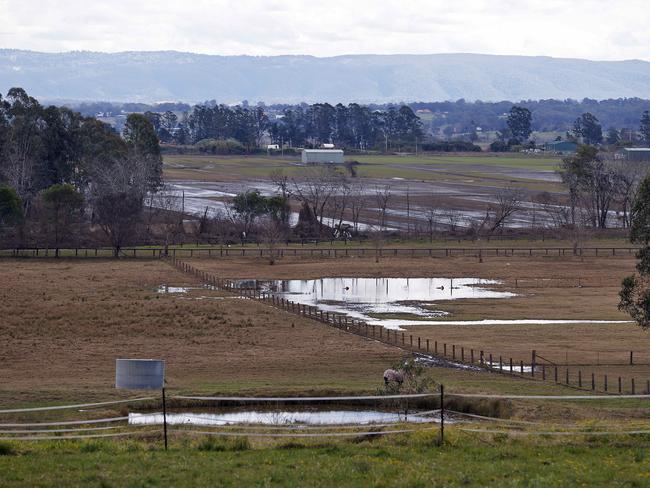Inside the suburb at the heart of Sydney’s flood dilemma
Dubbed the suburb that floods “as soon as someone flushes the toilet”, northwest Sydney residents are begging for help as a string of bureaucratic failures leave them stranded.
NSW
Don't miss out on the headlines from NSW. Followed categories will be added to My News.
It’s the Sydney suburb that floods “as soon as someone flushes the toilet” – and now its residents are asking how long they must remain stranded before the state government helps them.
As debate rages about whether large tracts of northwest Sydney should be developed in light of the floods, Pitt Town is the example of how things can go horribly wrong.
The town made famous as the backdrop for television series A Country Practice has seen its population triple in the past decade to reach almost 4000.
Yet three epic floods in the past 12 months – and even bouts of heavy rain separate from the main flood emergencies – have turned a brand new urban area into an island.
During the March flood, residents were left without power, sewerage and telecommunications for more than seven days.

They were forced to use a perilous evacuation route that runs through bushland.
“We knew that the Hawkesbury area would flood from time to time but to only have one access during the flood in and out of Pitt Town was not something that we expected,” father of three Adam Hall, who built a home in the new subdivision in 2015, said.


“We certainly thought that there were going to be improvements to the infrastructure, which would therefore have improvements to access during floods and natural disasters. We didn’t think we would have to navigate a goat track on Redfern Place to get in and out during a flood.”
The Committee for Sydney’s Sam Kernaghan believes there should also be options for NSW taxpayers to fund a land buy back.
One candidate would be Mawson Place in Pitt Town, which locals have dubbed “snorkel crescent” because houses are completely submerged during flooding.
During a visit to Pitt Town last Sunday, opposition leader Chris Minns said he plans to lower the maximum water capacity of Warragamba Dam and The Sunday Telegraph revealed last week Labor also plans a $9.6 million levee at Pitt Town.

The state government is also yet to release its evacuation and flood modelling report for the Hawkesbury and Nepean Valley, which would identify land too vulnerable to be built on. It would also influence the decision of whether to increase the height of the dam wall, which would offer more protection to low lying areas but potentially intensify development.
Stacy O’Toole has lived in Pitt Town for 28 years and lives in a house which dates back to 1825, which has not been flooded.
“The flood evacuation route – a route all our residents are forced to use in times of heavy rain – is flawed, incomplete and downright dangerous. This is lives at risk,” she said.
Pitt Town resident Jake Hargraves’ property predates the new subdivision.
Hawkesbury Council built a retention pit next to his property to ensure stormwater from the new homes doesn’t flood the area.

Yet during the March flood he had water lapping at his front door as the retention pit overflowed.
“I’m urging the council to fix this major infrastructure mess up,” he said.
Hawkesbury Council general manager Elizabeth Richardson said the “council is aware of the concerns ... and is undertaking a holistic review of the stormwater management across Pitt Town”.
HOW DREAM TURNED INTO SOGGY NIGHTMARE
One of the state’s leading property developers has called on Premier Dominic Perrottet to fix the “forgotten” suburb of Pitt Town, saying the current situation is “a disaster”.
Johnson Property Group developed large parts of Pitt Town from 2006.
Yet only 65 per cent of the 850 lots have been delivered, with a failed land deal leaving a large part of the precinct incomplete.
The suburb was supposed to have a boat ramp, public amenities and a “meandering river walk” that would “ensure the riverfront becomes a focal point for new and existing residents”.
The developer also offered three new sporting fields in marketing material. Yet 16 years on from when the former Labor state government signed a planning agreement with the company, the majority of those facilities have not been delivered.

“I’m not a greedy person. I just want to see it complete,” JPG managing director Keith Johnson said.
“But I’m not the bank of Pitt Town, I’m not the bank of the NSW Government and I’m not the bank of the local farmers. I am calling on Premier Dominic Perrottet and the state government to step in and fix this mess.
“He was the local member for Hawkesbury and understands the issues. Yet the local council’s dysfunction has meant the people of Pitt Town have been forgotten. It’s a disaster.”
Local resident Adam Hall said the area is in desperate need of a flood evacuation route to ensure 4000 residents can leave the area.
“All we want to do is to shine a light on this, and for whoever needs to take responsibility takes the responsibility to deliver what was promised,” Mr Hall said.
“People like ourselves who have been out here for six-and-a-half years made a conscious decision to move from established suburbs with the expectation that these things would be delivered in a timely way.”

In 2006 former planning minister Frank Sartor signed an agreement with JPG to charge owners $16.5 million (about $42,000 per lot) for infrastructure contributions. In 2011 the Planning Department issued JPG with a $26.4 million bill for developer contributions (an adjustment for CPI on the original $16.5 million). During that year the company briefly went into voluntary administration before emerging after doing a deal with creditors.
A 2017 Deed of Amendment to the 2006 Pitt Town planning agreement cut those contributions to $5.8 million plus the completion of a payment of $630,000. During a 2017 Budget Estimates hearing, former Greens MLC David Shoebridge described the deal as a “$10 million gift” to the developer.
Planning Minister Anthony Roberts, who was planning minister at the time the deed was signed, declined to comment.
One resident who purchased land in 2015, said if he buys a $1000 TV set from a retailer, he is protected by consumer law. “If I purchase a $1 million block of land, there is no protection whatsoever,” he said.
“All contracts of sale of land in NSW should be made to include clear details of all developer contributions, state and local government fees and other levies.
“All such payments should be made on settlement and paid directly to the state and local governments respectively, rather than to the developer.”
A department spokeswoman said: “In response to the Global Financial Crisis in 2008, the NSW Government decreased developer contributions by up to 50 per cent to ease pressure on the development industry and ensure development could continue to build homes, attract investment and create jobs.”

Mr Johnson said his company has offered to fix the boat ramp if the council would return a $1.5 million bond owed to him, yet council has never taken the offer. He also said his company spent more than $15 million providing improved power and water services which has benefited new and existing properties.
In 2018 Mr Johnson said his company has been unable to deliver remaining infrastructure “because of our exclusion from the Thornton Precinct”.
Mr Johnson was referring to 71 lots that were never developed because the landowner declined to sell to him.
Mr Johnson said this week the council could compulsorily acquire the land to complete the precinct and deliver the infrastructure required.
Hawkesbury Council general manager Elizabeth Richardson said it “is not the business of council to compulsorily acquire land to undertake residential development, and council is not considering such a proposal”.
“The inadequacy of current flood evacuation routes in the Hawkesbury is a significant concern to council and the community,” she said.
“The NSW Government through the Hawkesbury-Nepean Valley Flood Evacuation Road Resilience Program has responsibility for improving the evacuation routes and council would seek for these improvement works to be delivered in full as a priority.”




